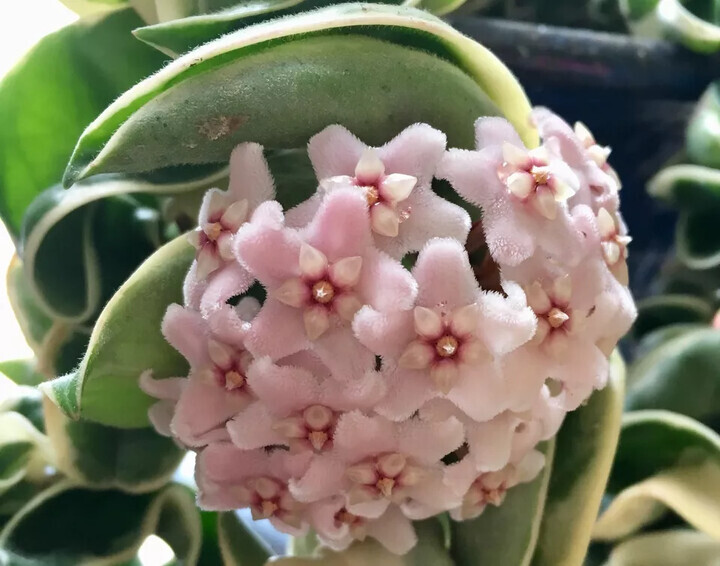
The Hindu rope plant (Hoya carnosa 'Compacta' or 'Krinkle Kurl') is a curly leaf version of the porcelain flower or wax plant (Hoya carnosa). This semi-succulent, perennial, vine-like species is known for its lush, waxy foliage and striking blooms. Native to India, they are most commonly kept as houseplants in North America and are regarded as being easy-to-care-for, slow-growing, long-lived, and great for novice plant lovers.
Unlike the Hoya carnosa, the Compacta variety has a pendulous growth habit and the trailing vines and leaves look great when hanging over elevated shelf ledges or in hanging baskets.
The beautiful pinkish-white and tiny star-shaped flowers are another element that makes this plant popular. They grow in ball-shaped clusters and appear from early spring right through the summer. The flowers can last up to a few weeks, and healthy plants flower prolifically.
You just have to be patient with a new plant, as it can take up to a few years before it starts to produce blooms.
Botanical Name :Hoya carnosa 'Compacta', Hoya carnosa 'Krinkle Kurls'
Common Name :Hindu Rope Plant
Plant Type :Semi-succulent, Perennial
Mature Size :Up to 15 in. long
Sun Exposure :Full Sun, Partial Shade
Soil Type :Well-drained
Soil pH :Acid, Neutral, Alkaline
Bloom Time :Spring, Summer
Flower Color :Usually light Pink
Hardiness Zones :9 - 12, USA
Native Area :Asia, Australia
Toxicity :Non-toxic
Plant Care
If you are a houseplant novice and looking for something that doesn't require too much maintenance, then a Hindu rope plant could be a perfect choice.
They just need a well-drained potting mix, a decent amount of warmth, and bright, indirect sunlight to thrive.
Light
Too much direct, intense sunlight can result in leaf scorch for Hindu rope plants and too little means their growth habit will be particularly slow, and they may not produce any flowers.
Bright but indirect light usually produces the best results in terms of growth and flowering. Avoid positioning your Hindu rope plant in a window that receives extended exposure to direct afternoon sun.
Soil
As you would expect with an epiphytic species (one that can grow on tbe branches of other plants), a heavy soil will not be suitable for the Hindu rope plant. It needs a fast-draining potting mix that is light and airy.
Soggy conditions will be the death of your plant, so additions of perlite, orchid bark, and peat can be helpful to ensure good drainage.
Water
Succulents store water in their foliage. Given that the Hindu rope plant is a semi-succulent species, it doesn't need a lot of water to survive. During its active growth period in the spring and summer, it will need more regular watering, but this should only be once the top few inches of the soil are fully dried out.
At this point, your plant will appreciate a deep watering, but you need to make sure it is growing in a pot with decent drainage holes. Waterlogged conditions are a big problem for this species and can result in flower drop and root rot. Be sure that, especially in the dormant winter period, you are conservative with how much you irrigate your Hindu rope plant.
Although this plant can survive periods of drought, if it is left dry for overly long periods, this can also result in flower drop, or it may not produce any blooms at all.
Temperature and Humidity
Hindu rope plants appreciate consistent and warm temperatures. Anything below 50oF will be a problem. Given most indoor temperatures are above this, however, this species tends to do well as a houseplant. Just be sure to protect it from sudden temperature changes. Positioning your plant beside a radiator or on a draughty windowsill should be avoided.
Low humidity levels can result in a loss of the waxy, glossy appearance that the plant's foliage is known for.
If your home environment is dry, you can use a humidifier to ensure lush green foliage and beautiful flowers appear. An alternative option is to stand the plant pot on top of a pebble-filled tray. This allows drained water to sit under the plant without touching the roots.
Fertilizer
To ensure your Hindu rope plant continues to produce lush, bright foliage and a profusion of healthy blooms, you can consider feeding it with a light dose of fertilizer during its growing season. It's enough to feed a weak solution just every couple of months, and the plant won't need any feeding during the winter.
Selecting a fertilizer that is high in potassium will help produce the best results in terms of flowering.
If the foliage and flowers are already healthy and abundant, you could leave it as it is. Overfeeding these plants is common and can result in the production of smaller than average leaves that can become crinkled and unsightly.
Hindu Rope Plant Varieties
There is a variegated version of this plant featuring leaves that have striking pink or creamy-white margins.
Propagating Hindu Rope Plants
Hindu rope plants can easily be propagated from stem cuttings. Take a piece of around four inches from a healthy stem. Remove the leaves from the lower section so that it can be rooted in a well-drained and airy potting soil. Be aware that the cuttings are slow to root and grow - just like the mature plants.
Potting and Repotting Hindu Rope Plants
These plants are very slow-growing and like to be pot-bound, so they won't need regular repotting.
In fact, potting them in a small container is usually recommended. They won't grow out of it quickly, and the smaller size will reduce the risk of overwatering.
Just make sure that whatever pot you select has sufficient drainage holes to prevent soggy conditions from developing.
If you're not sure if your Hindu rope plant needs repotting look for the soil drying out too quickly after watering, over compaction of the potting mix, and problems with thick roots blocking the pot drainage holes.